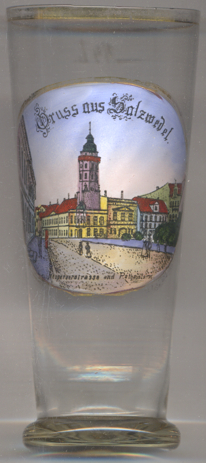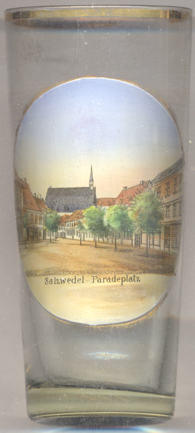

|
| DEUTSCHLAND | GERMANY |
| Bundesland: Sachsen-Anhalt | Saxony-Anhalt |
| Landkreis: Altmarkkreis Salzwedel |
 Salzwedel (official name: Hansestadt Salzwedel) is situated at an elevation of 19 m in the northwest of
the Altmark region where the Salzwedeler Dumme flows into the Jeetze, about 100 km northnorthwest of Saxon-Anhalt's
capital, Magdeburg. The municipality has a population of about 24,100
(2015). Salzwedel is the administrative seat of the district Altmarkkreis.
Salzwedel (official name: Hansestadt Salzwedel) is situated at an elevation of 19 m in the northwest of
the Altmark region where the Salzwedeler Dumme flows into the Jeetze, about 100 km northnorthwest of Saxon-Anhalt's
capital, Magdeburg. The municipality has a population of about 24,100
(2015). Salzwedel is the administrative seat of the district Altmarkkreis.
The castle of Salzwedel in the Altmark was first documented in 1112. As part of the Margraviate of Brandenburg, the settlement was first mentioned as a town in 1233. To the northeast of the old town (Altstadt), a new town (Neustadt) began development in 1247. In the Middle Ages Salzwedel belonged to the Hanseatic League from 1263 to 1518. In 1701 it became part of the Kingdom of Prussia. In 1713, the two towns Altstadt and Neustadt became one. Salzwedel became part of the Prussian Province of Saxony in 1815 after the Napoleonic Wars. In 1870 it received a railroad connection. The official name of the city was changed into Hansestadt Salzwedel on 1 April 2008, in reference to its history as a member of the Hanseatic League.
The former  Town Hall Tower [background centre] is the remainder of the
town hall of Neustadt, built in 1618 in Renaissance style. The town hall was destroyed by a large fire in 1895 and only
the tower remained. The tower is onpen to the public and offers a splendid view on the town.
Town Hall Tower [background centre] is the remainder of the
town hall of Neustadt, built in 1618 in Renaissance style. The town hall was destroyed by a large fire in 1895 and only
the tower remained. The tower is onpen to the public and offers a splendid view on the town.
The picture on glass no. 3259 is labeled "Neuperverstrasse und Rathausturm".
 The
The  Mönchskirche (monks' church) [left, no. 3637: background]
was built in 1250 for the order of the Franciscans. The earliest document mentioning the monastery dates from 1261.
The choir and the southern side aisle were added in 1345. Further enlargements followed between 1435 and 1500. After the
Reformation, the church came in possession of the town. The last Franciscan monk died in 1552. The enclosure of the
monastery subsequently was used as a grammar school. The church was remodeled for the Protestant community between 1575
and 1581. Since 1895 the former enclosure is used as the town hall of Salzwedel. The church was closed in 1964 and
began to fall into dereliction. It was renovated and converted into a concert hall in 1984–1986.
Mönchskirche (monks' church) [left, no. 3637: background]
was built in 1250 for the order of the Franciscans. The earliest document mentioning the monastery dates from 1261.
The choir and the southern side aisle were added in 1345. Further enlargements followed between 1435 and 1500. After the
Reformation, the church came in possession of the town. The last Franciscan monk died in 1552. The enclosure of the
monastery subsequently was used as a grammar school. The church was remodeled for the Protestant community between 1575
and 1581. Since 1895 the former enclosure is used as the town hall of Salzwedel. The church was closed in 1964 and
began to fall into dereliction. It was renovated and converted into a concert hall in 1984–1986.
The square depicted in the foreground is labeled
 Paradeplatz
Paradeplatz
 The top picture on glass no. 3788 [near left: top picture] shows the intersection
The top picture on glass no. 3788 [near left: top picture] shows the intersection
 Am Lüchower Tor
Am Lüchower Tor
The  Karlsturm [near left, no. 3788: bottom left picture] also was part
of the medieval town fortifications and is located in the souteast of the historic town centre of Salzwedel. It was
built around 1370.
Karlsturm [near left, no. 3788: bottom left picture] also was part
of the medieval town fortifications and is located in the souteast of the historic town centre of Salzwedel. It was
built around 1370.
The  Propstei ('provost seat') [near left, no. 3788: bottom right picture]
was built as a manor house in 1578 in Renaissance style. The sandstone portal in the central star tower was added in 1754.
Until 1806 the building was extraterritorial, i.e. not part of the town of Salzwedel. In 1928 it was purchased by the
municipality. In 1929 it became the home of the collection "Altmärkischer Verein für Vaterländische
Geschichte und Industrie" ('Altmark Association for Patriotic History and Industry'), which had been founded in 1836. In
1932 it was renamed Johann-Friedrich-Danneil-Museum, honouring the German prehistorian and pedagogue Johann Friedrich
Danneil (born
Propstei ('provost seat') [near left, no. 3788: bottom right picture]
was built as a manor house in 1578 in Renaissance style. The sandstone portal in the central star tower was added in 1754.
Until 1806 the building was extraterritorial, i.e. not part of the town of Salzwedel. In 1928 it was purchased by the
municipality. In 1929 it became the home of the collection "Altmärkischer Verein für Vaterländische
Geschichte und Industrie" ('Altmark Association for Patriotic History and Industry'), which had been founded in 1836. In
1932 it was renamed Johann-Friedrich-Danneil-Museum, honouring the German prehistorian and pedagogue Johann Friedrich
Danneil (born
[https://de.wikipedia.org/wiki/Salzwedel, https://en.wikipedia.org/wiki/Salzwedel, https://de.wikipedia.org/wiki/Altmarkkreis_Salzwedel;
http://erlebnisland.de/sachsen-anhalt/hansestadt-salzwedel/sehenswuerdigkeiten/rathausturm-touristinfo-rathausturmplatz-salzwedel,
http://www.salzwedel.de/de/stadt/stadtgeschichte.html;
https://de.wikipedia.org/wiki/Mönchskirche_(Salzwedel);
https://www.geocaching.com/geocache/GC3T4CQ_anno-1370-zu-salzwedel-karlsturm;
https://de.wikipedia.org/wiki/Johann-Friedrich-Danneil-Museum]
![[scale]](lineal.jpg)